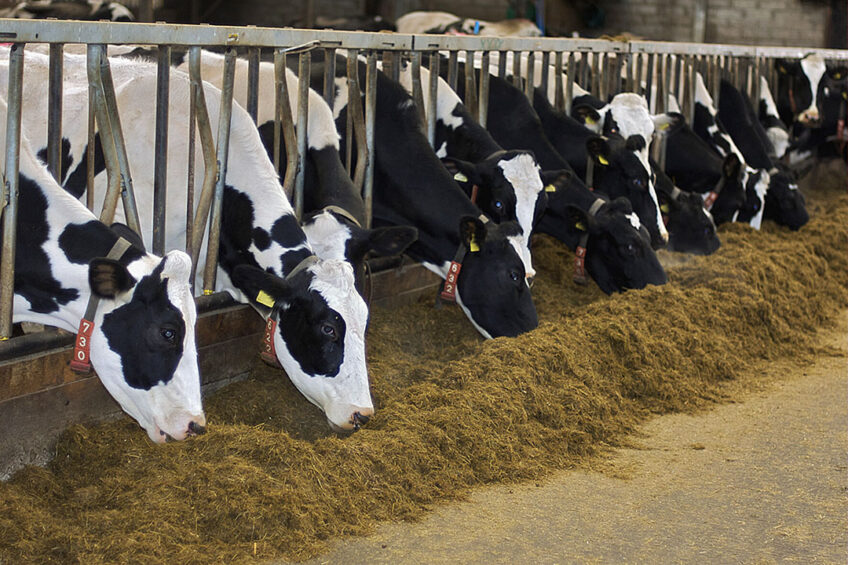Correctly balancing rations is key in dairy cow nutrition

Correctly balancing rations is key to making the most of forage this winter and an important aspect of rumen efficiency and dairy cow performance.
With good silage availability on many farms across the UK, the focus turns to the variable quality being experienced from region to region, and even farm to farm, warns KW Alternative Feeds, advising that correctly complementing forage quality will be key to maximising rumen efficiency and performance this winter.
“This year we have experienced the highest rainfall on record in February, followed by the dry, hot spring and the hottest temperatures for May on record,” says Charlotte Ward, ruminant technical manager at KW Alternative Feeds.
Since then, the weather has been very variable and localised, so there will be regional variations.”
Many farms have adequate levels of silage filling clamps this winter, but the opportunity to maximise milk from forage, to increase margin per litre, relies heavily on good ration formulation. Investing in the right complementary feeds will have a bigger positive impact on margins per litre than trying to cut costs with cheaper or less feed.

Now is the time to secure additional feed requirements
Some farms, particularly in the east and south east of the country, have not seen such a plentiful supply of silage, with some a little tight or even short going into winter. KW advises that it is best to act now to secure additional feed requirements, rather than having to dramatically change rations later on.
“Nutritional NIR analysis will give the quality of silage, allowing the farm to balance rations cost effectively,” says Charlotte. “Forage mineral testing will highlight any antagonists, for example high potassium locking up calcium and magnesium causing milk fever in grass silages, or high molybdenum and iron locking up copper, and will help to balance mineral status.”
The latest Trouw Nutrition analysis results for grass silages show that averages for protein are quite good, although lower than last year’s averages (14.3-14.9% CP), and there is considerable variation with results ranging from 5.7% up to 22.1% CP.
It is vital on farm to ensure you are balancing ‘your’ forage rather than the ‘average’ forage or you will lose out on milk,” explains Charlotte. “Average energy (10.7 to 11.4MJ ME/kg DM) values are generally good, with higher values seen in the earlier cuts, but again there is variation between cuts, within cuts, within individual clamps and across different farms.”
Trouw shows energy values ranging between 9.1 to 12.2 ME/kgDM, and Charlotte adds, “What that means in practical terms, is if a cow eats 10kg DM from forage and you overestimate the energy the forage supplies by 2MJ/kgDM, this means you will be 20MJ short in your ration. That equates to a loss of over 3.5 litres of milk, because you haven’t analysed your forage to understand your energy base.”
Charlotte believes many farms are going to struggle with intakes, whether at the overly dry, or overly wet, acidic ends of the spectrum. Average dry matters are generally higher than last year (around 35%), so improving palatability is going to be vital.
A number of this year’s grass silages also contain very high levels of lignin, with even early first cuts averaging over 33%, meaning it will be much harder for the rumen microbes to break down the silage fibre, which will slow digestion, cut passage rates and further restrict intakes.
 Maize: Ensure an airtight seal in the clamp
Maize: Ensure an airtight seal in the clamp
Maize silage is a high energy crop especially suitable for demanding cows but it can be an expensive forage to produce if not ensiled properly.
Additional fermentable energy
On average the NDF levels in this year’s grass silages are normal, but the higher lignin levels mean this fibre is less digestible, so silage may not feed as well as it should on paper.
“What’s needed is additional quickly fermentable energy (FME) to boost microbial activity in the rumen, aiming for a mix of starch and sugars (minimum of 5% sugars on a DM basis) and an ideal starch:sugar ratio of 3:1,” continues Charlotte.
Good options to consider include the more rumen-friendly starch sources like Soda Wheat, Soda Barley and ground maize, or more balanced feeds like SugaRich dairy biscuit meal, which contains starch, sugars and oil.
“The higher fibre levels in the silages will allow some greater use of rolled cereals,” she adds. “But remember that for higher yielding herds, +9,000 litres/cow, the risk of acidosis will already be high and starch sources with a lower acid loading will be the better choice.”
For sugars, Charlotte recommends one of the high sugar liquid feeds, such as Molale, which contain in excess of 50% sugars (DM basis). Liquid feeds will also balance the high dry matter of many silages, ensuring the final ration is not too dry, typically aiming for 45% DM. This will minimise sorting whilst maximising intakes.
 Chickpeas for cattle nutrition: hummus not just for humans
Chickpeas for cattle nutrition: hummus not just for humans
From hummus to stews, chickpeas are the star of many recipes. Recently, a study by Dr Peiqiang Yu et al showed the legume’s potential as cattle feed.
“Liquid feeds are great for increasing ration palatability, boosting intakes and binding the various ration ingredients together,” Charlotte explains. “The result is not only a higher intake of nutrients overall, but a more consistent intake that further improves rumen efficiency and milk from forage in particular.”
Spreading energy supply
Using a selection of feeds to provide the necessary extra fermentable energy (FME) will also spread the rate of release in the rumen. This is critical to drive and support fibre breakdown, as well as capture and efficiently utilise the rumen degradable protein (RDP) in some of this year’s grass silages.
This is especially true where grass silage is the only or predominant forage in the ration, increasing the risk of excess nitrogen in the rumen. As well as representing a loss of valuable nutrients, excreting this nitrogen requires energy that could otherwise be used for milk production.
“The fast release of sugar energy from liquid feeds is particularly useful in matching the rapid breakdown of grass silage RDP, and ensures the balance of nutrients needed for the microbes to capture the resulting nitrogen into growth. Liquids also have a low substitution rate, so adding one to the ration will increase the overall intakes,” says Charlotte.
 Dairy cows: Top 5 sustainable approaches to protein nutrition
Dairy cows: Top 5 sustainable approaches to protein nutrition
The symbiotic relationship between the dairy cow and the rumen microbial population is the cornerstone of ruminant nutrition.
Considering the source of rumen-bypass protein
The other factor to consider is the source of rumen-bypass protein (digestible undegraded protein, DUP) in the ration.
NovaPro is a xylig-treated British rapeseed expeller, which supplies similar levels of DUP to soya, with considerably less cost and a lower environmental impact. In rations with high levels of RDP coming from high protein grass silage, using NovaPro in the ration can help to improve nitrogen efficiency and reduce nitrogen pollution.
Where additional rumen degradable protein is needed to balance low crude protein silages, Charlotte advises to look to high protein liquids, distillers grains and moist feeds such as TraffordGold.
Concluding, Charlotte explains, “If you don’t measure it, you can’t manage it , and going forward with many farmers still trying to recover from the impact of Covid-19 on their milk contracts earlier in the year, and uncertainty around Brexit, tariffs and more Covid-19 disruptions ahead, it’s never been more important to maximise farm efficiency.”
Author: Stuart Booker
Join 13,000+ subscribers
Subscribe to our newsletter to stay updated about all the need-to-know content in the dairy sector, two times a week.










